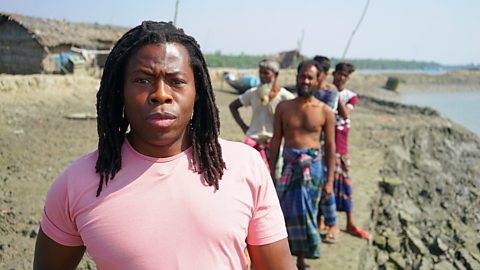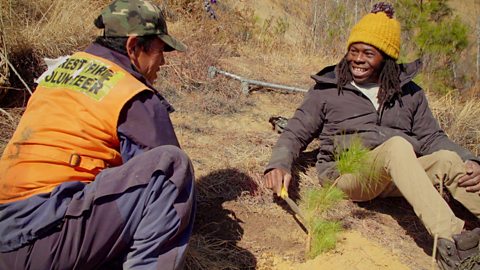Ade Adepitan visits Dhaka, Bangladesh, to discover how rising sea levels are causing mass migration to the city.
ADE: Hi, my nameãs Ade Adepitan and Iãm in Bangladesh on a ferry heading towards the capital city Dhaka and this is what a lot of people do when theyãre hit by the effects of climate change ã they go to somewhere which is safer to find work and to earn money for their families.
A quarter of Bangladesh is just a few feet about sea level, so this country is incredibly vulnerable to climate change. Some people in these low lying rural areas are running out of options, so theyãre packing up and heading for the city.
Such a busy port! How many boats along here?
TANJIL: Uh, every day more than 200 boats comes and goes.
ADE: Dhaka is Bangladeshãs biggest city. And itãs one of the most crowded cities on the entire planet.
If you listen carefully youãll hear the soundtrack of Dhaka. Probably the soundtrack of Bangladesh. [SOUND OF CAR HORNS] There it is. There it is. Should be the Bangladeshi national anthem.
Every single day more than a thousand people migrate here. And climate change is one of the biggest drivers of that migration.
TANJIL: The Dhaka population has doubled in last 20 years from 10 millions to 20 millions.
ADE: I mean that is, that is like the equivalent of London and then some added onto Dhaka in, in 20 years.
TANJIL: Yeah.
ADE: Thatãs enormous!
The city is struggling to cope with the influx of climate refugees. Millions have to cram into whatever space they can find, often without access to even basic sanitation.
TANJIL: So this is just like, rooms you can hire. [SPEAKS BANGLADESHI] Would we be able to squeeze in? So we can try.
ADE: Ready, push.
TANJIL: Yes, push.
ADE: There we go.
TANJIL: Yeah.
ADE: Ok. Thereãs barely enough room for me to get past but yeah.
TANJIL: Somebodyãs living here, somebodyãs living here, somebodyãs living there, somebodyãs living there and somebodyãs living there.
ADE: What a way to live. What a way to live.
The huge changes here are a glimpse of a global future. Worldwide itãs predicted climate change will cause the migration of 200 million people by 2050.
Video summary
Ade Adepitan meets climate refugees in Bangladesh, who have been forced by rising sea levels to seek a new life in their capital city of Dhaka.
With a quarter of Bangladesh lying less than seven feet above sea level, climate change is threatening to inundate much of the country. Many people in the countryãs low-lying rural areas are running out of options, so are migrating to the city. The population of Dhaka has doubled in the last 20 years from 10 to 20 million people.
This clip is taken from the ôÕÑ¿èÓ Two series Climate change: Ade on the frontline.
Teacher Notes
Before watching the film
You might want to recap what students know and think about Bangladesh.
You could create a poll and ask students to give three words that come to mind when thinking of Bangladesh and / or Dhaka and discuss what the class consensus indicates. This would help assess prior knowledge and misconceptions and also provide a talking point to return to after watching the film.
During the film
You may wish to stop at relevant points during this short film to pose questions and check understanding or wait until the end. Useful questions might include:
- Why are people migrating to the city?
- What is the soundtrack of Dhaka?
- How many people migrate here each day? (more than 1000)
- How much has the population grown by in the last 20 years? (doubled to 20 million)
- What kind of a place is this? You could stop the film at various points and ask students to describe what they can see or you might use some screen grabs together for a later activity to build a sense of place.
- What would it feel like to live here?
Following on from the film
Use maps to locate Bangladesh, and the capital city of Dhaka and use these to discuss the problems of flooding and why this is so bad here. As well as being a low-lying country, most of the land forms a delta from three main rivers ã the Ganges, Brahmaputra and Meghna - which seasonally flood. Heavy monsoon rains and melt water from the Himalayas contribute to seasonal flooding and other factors such as deforestation also play a part. In the past these flood events have created fertile floodplains for agriculture but climate change means that the rate and increase of flooding now threatens peopleãs daily lives.
Discuss the film afterwards and develop the sense of place, the bustling urbanisation and what it might feel like to live there. You might use a sound-track of the city over some screen grabs showing different views of the streets and buildings and the people living there to develop this and describe what can be seen and heard. You could ask students how this compared with their original ideas.
You could explore the phrase ãclimate refugeeã and ask students to provide a clear explanation for this term. You could then discuss and identify the push and pull factors of migration and the environmental factors that have caused people to make this journey.
Students could make a list of the ãpullã factors towards Dhaka such as the thought of a better life, jobs and increased security; and the ãpushã factors taking them away from the low-lying rural areas such as the loss of their homes and livelihoods, crop failure, and poverty.
You could watch the film again and ask students to gather numerical statistics that help explain the scale of the problem. If more than a 1000 people are arriving each day and the population has doubled in the last twenty years what might the future hold? Can students suggest mitigation and adaptation strategies that could help?
This short film is suitable for teaching KS3 and KS4 students. All of the films build on studentsã understanding of climate change issues and enable them to make global connections and they can be watched on their own or in conjunction with others. However, this clip works particularly well with the other three clips on Bhutan and Bangladesh as these reveal the interconnectedness of human and physical landscapes.
At KS3, the film supports understanding about human and environment interaction, urbanisation, connections within places in the context of Asia and how changing climate impacts on peopleãs lives.
At KS4, the films particularly supports studies on urbanisation and migration, and the impacts and management of climate change.
This clip could be used to support the delivery of geography to KS3 and KS4 students. Specifically, this topic appears in OCR, Edexcel, AQA, WJEC KS4/GCSE in England and Wales, CCEA GCSE in Northern Ireland and SQA National 4/5 in Scotland.
Rising sea levels in Bangladesh. video
Ade Adepitan travels to Bangladesh to find out how a combination of rising sea levels and extreme weather events is affecting life.

Melting glaciers in Bhutan. video
Ade Adepitan visits Bhutan to see the effects of rising temperatures on the glaciers there, and the danger this poses to the communities further down the valleys.

Planting trees in Bhutan. video
Ade Adepitan meets Sonam Phuntsho, who has planted more than one hundred thousand trees in Bhutan. Planting trees is one of the cheapest and most effective ways we have of tackling climate change.
